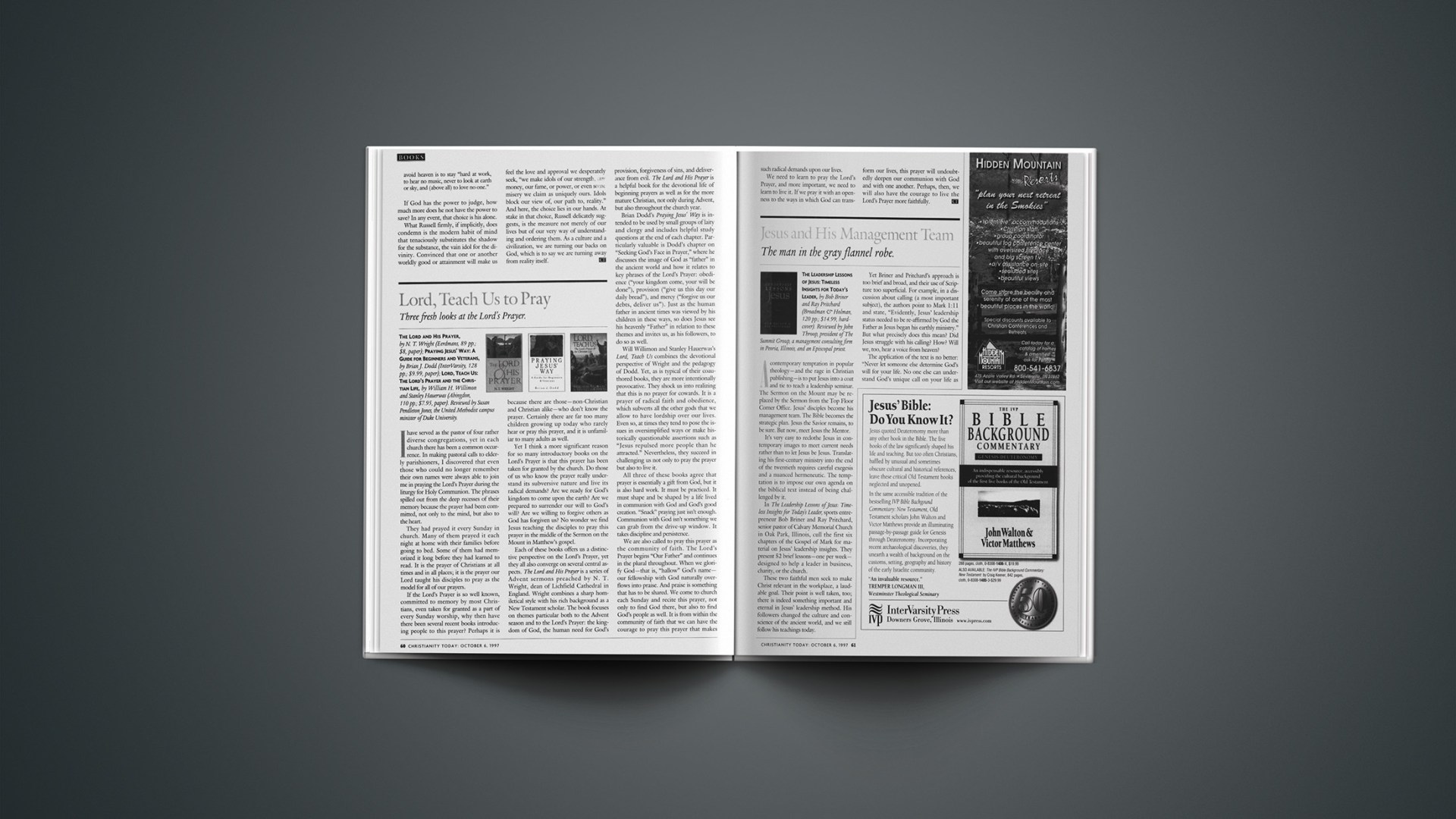The Lord and His Prayer,by N. T. Wright (Eerdmans, 89 pp.; $8, paper);
Praying Jesus’ Way: A Guide for Beginners and Veterans,by Brian J. Dodd (InterVarsity, 128 pp.; $9.99, paper);
Lord, Teach Us: The Lord’s Prayer and the Christian Life,by William H. Willimon and Stanley Hauerwas (Abingdon, 110 pp.; $7.95, paper). Reviewed by Susan Pendleton Jones, the United Methodist campus minister of Duke University.
I have served as the pastor of four rather diverse congregations, yet in each church there has been a common occurrence. In making pastoral calls to elderly parishioners, I discovered that even those who could no longer remember their own names were always able to join me in praying the Lord’s Prayer during the liturgy for Holy Communion. The phrases spilled out from the deep recesses of their memory because the prayer had been committed, not only to the mind, but also to the heart.
They had prayed it every Sunday in church. Many of them prayed it each night at home with their families before going to bed. Some of them had memorized it long before they had learned to read. It is the prayer of Christians at all times and in all places; it is the prayer our Lord taught his disciples to pray as the model for all of our prayers.
If the Lord’s Prayer is so well known, committed to memory by most Christians, even taken for granted as a part of every Sunday worship, why then have there been several recent books introducing people to this prayer? Perhaps it is because there are those—non-Christian and Christian alike—who don’t know the prayer. Certainly there are far too many children growing up today who rarely hear or pray this prayer, and it is unfamiliar to many adults as well.
Yet I think a more significant reason for so many introductory books on the Lord’s Prayer is that this prayer has been taken for granted by the church. Do those of us who know the prayer really understand its subversive nature and live its radical demands? Are we ready for God’s kingdom to come upon the earth? Are we prepared to surrender our will to God’s will? Are we willing to forgive others as God has forgiven us? No wonder we find Jesus teaching the disciples to pray this prayer in the middle of the Sermon on the Mount in Matthew’s gospel.
Each of these books offers us a distinctive perspective on the Lord’s Prayer, yet they all also converge on several central aspects. The Lord and His Prayer is a series of Advent sermons preached by N. T. Wright, dean of Lichfield Cathedral in England. Wright combines a sharp homiletical style with his rich background as a New Testament scholar. The book focuses on themes particular both to the Advent season and to the Lord’s Prayer: the kingdom of God, the human need for God’s provision, forgiveness of sins, and deliverance from evil. The Lord and His Prayer is a helpful book for the devotional life of beginning prayers as well as for the more mature Christian, not only during Advent, but also throughout the church year.
Brian Dodd’s Praying Jesus’ Way is intended to be used by small groups of laity and clergy and includes helpful study questions at the end of each chapter. Particularly valuable is Dodd’s chapter on “Seeking God’s Face in Prayer,” where he discusses the image of God as “father” in the ancient world and how it relates to key phrases of the Lord’s Prayer: obedience (“your kingdom come, your will be done”), provision (“give us this day our daily bread”), and mercy (“forgive us our debts, deliver us”). Just as the human father in ancient times was viewed by his children in these ways, so does Jesus see his heavenly “Father” in relation to these themes and invites us, as his followers, to do so as well.
Will Willimon and Stanley Hauerwas’s Lord, Teach Us combines the devotional perspective of Wright and the pedagogy of Dodd. Yet, as is typical of their coauthored books, they are more intentionally provocative. They shock us into realizing that this is no prayer for cowards. It is a prayer of radical faith and obedience, which subverts all the other gods that we allow to have lordship over our lives. Even so, at times they tend to pose the issues in oversimplified ways or make historically questionable assertions such as “Jesus repulsed more people than he attracted.” Nevertheless, they succeed in challenging us not only to pray the prayer but also to live it.
All three of these books agree that prayer is essentially a gift from God, but it is also hard work. It must be practiced. It must shape and be shaped by a life lived in communion with God and God’s good creation. “Snack” praying just isn’t enough. Communion with God isn’t something we can grab from the drive-up window. It takes discipline and persistence.
We are also called to pray this prayer as the community of faith. The Lord’s Prayer begins “Our Father” and continues in the plural throughout. When we glorify God—that is, “hallow” God’s name—our fellowship with God naturally overflows into praise. And praise is something that has to be shared. We come to church each Sunday and recite this prayer, not only to find God there, but also to find God’s people as well. It is from within the community of faith that we can have the courage to pray this prayer that makes such radical demands upon our lives.
We need to learn to pray the Lord’s Prayer, and more important, we need to learn to live it. If we pray it with an openness to the ways in which God can transform our lives, this prayer will undoubtedly deepen our communion with God and with one another. Perhaps, then, we will also have the courage to live the Lord’s Prayer more faithfully.
Copyright © 1997 Christianity Today. Click for reprint information.










